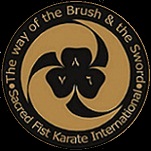Similarly to budō,
bujutsu is a compound of the roots
bu
(武), and
jutsu
(術:じゅつ), meaning science, craft, or art.Thus, budō is most often
translated as "the way of war", or "martial way", while bujutsu is
translated as "science of war" or "martial craft." However, both budō
and bujutsu are used interchangeably in English with the term "martial
arts".Budo and bujutsu have quite a delicate difference, whereas
bujutsu only gives attention to the physical part of fighting (how to
best defeat an enemy), budo also gives attention to the mind and how
you should develop yourself. Modern budo uses aspects of the lifestyle
of the samurai of feudal Japan and translates them to self-development
in modern life.
Budō
designates what are popularly known as the martial arts, although in
Japanese, art or jutsu 術 is conceptually quite different from way or
dō. While the two ideas are too complicated, overlapping and contested
than can be fully explained here, as a working distinction the bujutsu
武術 or martial arts emphasize deadliness on the feudal battlefield,
while the budō or martial ways emphasize spiritual transformation. The
budō include the more familiar, such as
jūdō
柔道 and aikidō 合気道, and the less well-known, such as
kendō
剣道, the way of the sword;
kyudō
弓道, the way of the bow and arrow; and
naginata-dō
長刀道, the way of the halberd. The most widely practiced budō in the
world today is
karate-dō, the
way of the empty hand.
The divide between East and West is figured by how the word budō
itself is read. On this side of the Pacific, the budō are classified
according to bu, the martial aspect, so that they are seen as akin to
boxing, UFC mixed
martial arts or
WWE wrestling. In Japan, however, they are understood as
dō,
as particular incarnations of much more general ways of being. “Dō” is
the Japanese pronunciation of the character 道, well-known as the
Tao
of Taoism. The budō are, at their heart, the same kind of cultural
pursuit as the
geidō, 藝道, the
ways of art, such as
shodō
書道, the way of the brush or calligraphy;
kadō
華道, the way of flower arrangement, also called
ikebana
生け花; and sadō,
茶道, the way of tea. The Japanese honor the great exponents of
swordsmanship and the tea ceremony in exactly the same manner. In this
way, the misconception of the budō as “martial arts” carries an
accidental truth reminiscent of imaginary etymology, for the expert
karateka 空手家 (practitioner of karate) is, in a strong sense, an artist
very much like an accomplished actor of Noh 能, the classical dramatic
form of Japan.
Civilian vs. Military
Many consider budō a more civilian form of martial arts, as an
interpretation or evolution of the older bujutsu, which they
categorize as a more militaristic style or strategy.According to this
distinction, the modern civilian art de-emphasizes practicality and
effectiveness in favor of personal development from a fitness or
spiritual perspective. The difference is between the more "civilian"
versus "military" aspects of combat and personal development. They see
budō and bujutsu as representing a particular strategy or philosophy
regarding combat systems, but still, the terms are rather loosely
applied and often interchangeable.
Art vs. Lifestyle
One view is that a jutsu is the martial art you practice, whereas a do
is the lifestyle you live and the path you walk by practicing a jutsu.
For example, one could say that Judo and Jujutsu practiced as a
practiced martial art are one and the same, being that the practice of
the art Jujutsu leads to obtaining the lifestyle of Judo (it should be
noted that Judo was originally known as Kano Jujutsu, after Judo's
founder Kano Jigoro). That would be true with arts such as
kenjutsu/kendo and iaijutsu/iaido as well.
Tea Ceremony
The tea ceremony is traditionally held in a special place, a
chashitsu
茶室 or tea hut. Subtle but rigorous Japanese aesthetics mandate a set
of specific architectural elements for the proper chashitsu, but one
aspect is obvious even to the uninitiated: its only entrance is two
feet tall. This doorway is called a
nijiri guchi
躙り口, which translates roughly as “crawling in space.” The great tea
master, Sen no Rikyu (1522 – 1591) invented the nijiri guchi for a
very specific purpose.
Rikyu’s most famous pupil in the Way of tea was Toyotomi Hideyoshi,
the fierce warlord who ruled much of Japan during the latter half of
the sixteenth century. Hideyoshi was passionate about the tea
ceremony. He saw in its sober and refined elegance a goal he
desperately pursued. But with Hideyoshi, it was always an inner battle
between his wish for the simple beauty that he knew marked a true
connoisseur, and his fevered and ambitious ego. He knew in his heart
that the quiet simplicity of the tea hut was an aesthetic to be
treasured. Yet it was difficult for him to give up the magnificent
clothes and the fabulously expensive swords he wore, the trappings of
his status as a shogun. He identified his position with these things,
and he did not wish to be without them…. Sen no Rikyu devised the
nijiri guchi so that if the haughty Hideyoshi wished to enter
sincerely into the spirit of tea, he would have to humble himself and
crawl through the door.
The tea ceremony is open to everyone, regardless of rank, status or
power, but there is only one way to enter: on one’s knees.Karate-dō is
likewise, and even more. It begins with humility, personified by the
chajin
茶人, “person of tea,” on her/his knees, and ends in exactly the same
place, one of many ways in which it is structured and practiced as a
circle. From the outside, karate-dō seems all kicks, punches and wild
screams, a particularly energetic assertion of the self, but its
fundamental aim is the opposite.
Gichin Funakoshi (1858 - 1957) was a schoolteacher who brought karate
from its Okinawan birthplace to the Japanese mainland and worked to
converge it to extant traditions of budō. To that end, he authored his
Nijū kun
二十訓, “twenty precepts” for karate-dō. The very first is, “do not
forget that karate-dō begins and ends with rei”. Rei means “bow,” but
also all the bow connotes: “this bodily gesture is a reminder and
result of giving up the self, as well as a catalyst that causes the
self to be given up”. Often the bow is done in a formal kneeling
position, seiza
正座, recapitulating how one must enter the chashitsu (the literal
translation of seiza is “correct sitting”). Even when the bow is done
from a standing position, its meaning and function are to make one
smaller, so in contrast to diet and exercise regimes in the West,
diminishing the body is not a way to grow as a person. In this
respect, at least, the famously convoluted and paradoxical Japanese
mind is much more consistent than its Western counterpart. In budō,
the repeated bowing that is part of every training session is both a
reminder and a catalyst to keep working to diminish the self in all
respects. |













